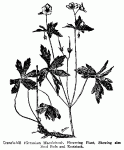Crane's-Bill. Geranium maculatum L.
OTHER COMMON NAMES—Spotted crane's-bill, wild crane's-bill, stork's-bill, spotted geranium, wild geranium, alum-root, alum-bloom, chocolate-flower, crowfoot, dovefoot, old-maid's-nightcap, shameface.
HABITAT AND RANGE—Crane's Bill flourishes in low grounds and open woods from Newfoundland to Manitoba, south to Georgia and Missouri.
DESCRIPTION OF PLANT—This pretty perennial plant belongs to the geranium family (Geraniaceae) and will grow sometimes to a height of 2 feet, but more generally it is only about a foot in height. The entire plant is more or less covered with hairs, and is erect and usually unbranched. The leaves are nearly circular or. somewhat heart shaped in outline, 3 to 6 inches wide, deeply parted into three or five parts, each division again cleft and toothed. The basal leaves are borne on long stems, while those above have short stems. The flowers, which appear from April to June, are borne in a loose cluster; they are rose purple, pale or violet in color, about 1 inch or 1 ½ inches wide, the petals delicately veined and woolly at the base and the sepals or calyx lobes with a bristle-shaped point, soft-hairy, the margins having a fringe of more bristly hairs. The fruit consists of a beaked capsule, springing open elastically, and dividing into five cells, each cell containing one seed.
DESCRIPTION OF ROOTSTOCK—When removed from the earth the rootstock of Crane's-bill is about 2 to 4 inches long, thick, with numerous branches bearing the young buds for next season's growth and scars showing the remains of stems of previous years, brown outside, white and fleshy internally, and with several stout roots. When dry, the rootstock turns a darker brown, is finely wrinkled externally, and has a rough spiny appearance, caused by the shrinking of the buds and branches and the numerous stem scars with which the root is studded. Internally it is of a somewhat purplish color. Crane's-bill root is without odor and the taste is very astringent.
COLLECTION, PRICES AND USES—Crane's-bill root depends for its medicinal value on its astringent properties and as its astringency is due to the tannin content, the root should, of course, be collected at that season of the year when it is richest in that constituent. Experiments have proved that the yield of tannin in Crane's-bill is greatest just before flowering, which is in April or May, according to locality. It should, therefore, be collected just before the flowering periods, and not, as is commonly the case, in autumn. The price of this root ranges from 4 to 8 cents a pound.
Crane's-bill root, which is official in the United States Pharmacopeia, is used as a tonic and astringent.
Ginseng and Other Medicinal Plants, 1936, was written by A. R. Harding.


